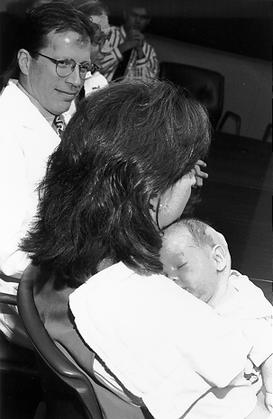Groundbreaking surgery for spina bifida performed

Dr. Joseph Bruner (left) looked on recently as Cory Meyer talked about the spina bifida procedure performed on her son, Daniel. (photo by Donna Marie Jones)
A Nashville infant born with spina bifida may have a more normal life, thanks to a first-of-its-kind surgical procedure performed while he was still nestled in his mother's womb.
The groundbreaking procedure ‹ performed at Vanderbilt University Medical Center ‹ involved opening the mother's abdomen and uterus, partially removing the fetus and sewing shut the opening over the fetus's spinal cord. Previous fetal surgery for spina bifida at VUMC and elsewhere had been perfomed endoscopically.
VUMC is one of only three medical centers in the United States doing open fetal surgery, and it is the only institution in the world performing such surgery to repair spina bifida lesions on a fetus still in its mother's womb.
The infant, Daniel Meyer, born June 12 to Cory and Scott Meyer of Nashville, still suffers from marked weakness in his lower body, but is able to flex his hips and appears to have good bladder and bowel function.
Spina bifida is the most common neurologic birth defect in the United States, occurring in 1.5 to 2 out of every 1,000 live births. Babies born with the defect have an opening in their spine, and although it is not considered to be a lethal disorder, in most cases it is severely handicapping. Babies typically have lower extremity weakness or paralysis, sensory loss, dysfunction of urinary or bowel functions, and are prone to develop hydrocephalus, or the increase of spinal fluid in the brain.
About 95 percent of babies born with spina bifida require a drainage shunt placed in the brain to help remove excess fluid.
Dr. Joseph P. Bruner, assistant professor of Obstetrics and Gynecology, is optimistic about the results of the operation, even though Daniel did also require a shunt.
Bruner is part of a team of VUMC researchers ‹ which includes Dr. Noel B. Tulipan, associate professor of Neurosurgery, and Dr. William F. Walsh, associate professor of Pediatrics ‹ testing the feasibility of the pioneering technique.
The research is a natural progression from animal studies in the mid-1980s at other institutions that looked at the exposed spinal cords of rats and monkeys and the abnormal development of the spinal cord due to those openings.
"From these studies, researchers came up with the 'two hit' hypothesis for neurological deficits with spina bifida," Bruner said. "The first hit is the fact that the fetus has spina bifida and the spinal cord is developing in an abnormal fashion. The second hit results from the prolonged exposure of the spinal cord to amniotic fluid. These studies have been repeated in sheep and pigs and show the same thing. If you protect the spinal cord from the intrauterine environment, the baby will develop more normally. If you expose the spinal cord to the fluid, the baby will develop neurologic lesions."
This led Vanderbilt researchers first to the animal labs, then to a human study three years ago for the first attempt at fetal surgery to protect the spinal cord from the possible damaging effects of sustained exposure to amniotic fluid. That technique, now replaced by the new technique performed on Daniel, was used four times during the past three years.
Endoscopic surgery using the earlier technique was done in the second trimester, at 22 weeks of pregnancy. The spinal cord was repaired by covering the opening in the spine with a skin graft taken from the leg of the mother. The graft was sealed in place with "biologic glue" made from fibrin from the mother's blood and thrombin, a substance derived from cows.
During the procedure, Vanderbilt surgeons removed amniotic fluid surrounding the fetus and replaced it with carbon dioxide to allow them to work inside the uterus with an unobstructed view.
Of the four repairs using the previous technique, one child is almost three. He suffers from only a mild weakness in his ankles. One child is four months old with weakness in one leg. Two others have died.
In the meantime basic laboratory research at VUMC has shown that the major damage from amniotic fluid occurs late in pregnancy.
"Armed with this information, we decided that rather than trying to cover this lesion very early in pregnancy, we could wait until later," Bruner said.
The new procedure performed on Daniel is done at 28 weeks, or the third trimester.
"This means that at this point we can actually do the same procedure to repair the spine that is done after delivery in spina bifida patients. We couldn't do that at 22 weeks because the skin isn't developed enough. At 28 weeks, the skin is strong enough," Bruner said.
VUMC is authorized to do five of the new procedures to test for the feasibility of the technique. A randomized trial will most likely follow to see whether the procedure improves outcomes for these children.
"We're a long way from knowing that intrauterine surgery improves outcome. Prior studies showed that only 6 percent of children were mildly affected. Compare that to our series where two-thirds have been mildly affected and it's encouraging," Bruner said.
"But the numbers are too small at this point to prove anything."













